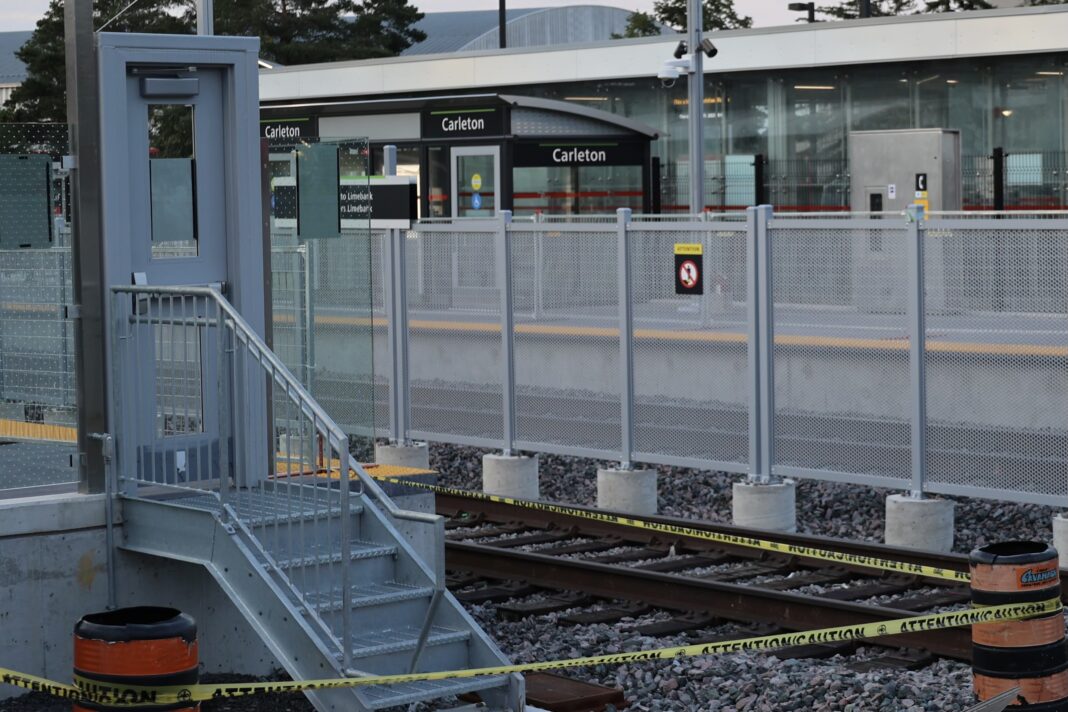There is a light at the end of the tunnel for Carleton University students as Ottawa’s O-Train Line 2 (the Trillium Line) extension project advances toward trial in August.
The Stage 2 O-Train South extension project will extend Line 2 to Limebank Station. An extension to the Ottawa International Airport, Line 4, will also be added.
“Before advancing towards a set date, trial tests must be performed between Bayview and Limebank. This trigger will likely be very close in August,” city Transit General Manager Renee Amilcar said. “If successful, the LRT sub-committee will meet in September and deliver a firm set date.”
Previously, the Trillium line was on track to reopen this September.
According to Denise Lamoureux, acting director of Ottawa’s Rail Construction Program, construction is finalized after being underway since May 2020, moving Line 2 and Line 4 into testing and commissioning.
Michael Morgan, director of Ottawa’s Rail Construction Program, emphasized the outstanding tasks at a recent council meeting.
“[We are] waiting until achieving confidence in the system before directing the project toward training ambitions and familiarization programs,” Morgan said.
After completing system trial tests, OCTranspo services will advance to training and employee familiarization programs.
Lamoureux said Ottawa plans to keep the Line 2 replacement bus service between Bayview and South Keys stations operating as part of the transition.
This Line 2 bus route parallels the Trillium Line and allows students access along the north-south rail line. The current service on Route 97 to the airport and Route 99 through Riverside South will similarly operate until Trillium launches.
For some Carleton transit users, the replacement service has not met expectations.
Brooke Muzzatti, a second-year Global and International Studies student at Carleton, said she found the Line 2 bus unpredictable last year.
“I think the most frustrating thing is that the buses are never on time,” Muzzatti said. “Having a source of communication to help make [transportation] decisions would be great.”
Following the 2021 O-Train Line 1 (Confederation Line) derailment at Tunney’s Pasture Station and stoppage on the same line, a general distrust for LRT service looms.
Jie Liu, a Carleton Mechanical and Aerospace Engineering professor, believes LRT system shutdowns are due to bearing issues that can be avoided with the relevant technology.
His ongoing research project aims to develop novel monitoring equipment for industrial services. With this technology, Liu claims the many tell-tale signs indicating a fault could be detected before disaster.
“We need condition monitoring,” Liu said. “To look at the [bearings] very closely, and remotely. If there was a problem, we would know earlier and not too late.”
Many bearing systems naturally deteriorate over time, which Liu said should be quickly identified during the inspection window.
“They missed the inspection. To damage a bearing, it isn’t easy and it takes a long time.”
As for when we will see Liu’s condition monitoring within LRT systems, he says next calendar year—at the earliest.
Muzzatti said she hopes to see better reliability and frequency from Line 2.
“When [the bus] doesn’t come, I don’t know if it is going to be slightly late, delayed until the next scheduled arrival or come at all,” she said. “I end up going from ten minutes late to forty-five minutes late for work.”
However, several new operational enhancements to strengthen service and overcome delays at Carleton Station hope to excite students about commuting next year.
“All former Line 2 stations, including Carleton Station, have been enhanced to now have 77-metre-long platforms to accommodate the longer Stadler trains and two-car Alstom Lint trains,” Lamoureux said. “This will almost double the capacity for students travelling to and from Carleton University by train.”
Besides Carleton Station improvements, the Trillium line now features two-track terminal stations at Bayview and Limebank and extensive two-track railing in the southern extension. It also features Ellwood Diamond rail-bridge construction allowing VIA trains to pass below Line 2 without impacting service.
The Rideau River Pedestrian Bridge, catering to pedestrians and cyclists, will also open for public access, coinciding with the Line 2 rail service launch.
For students, an improved transportation service is an exciting prospect.
“Especially for students heading to class,” Muzzatti observed. “They know, ‘I can be there on time.'”
Featured image by Nick Brousseau.






